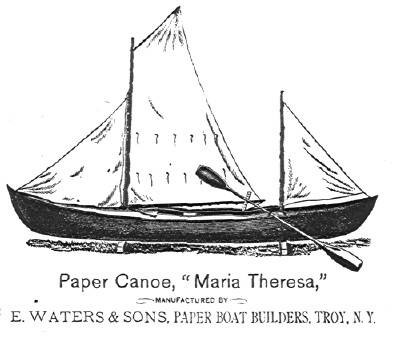
After Nathaniel Bishop paddled a Waters paper canoe from its place of manufacture in Troy all the way to the Gulf of Mexico, he sent the craft, dubbed the “Maria Theresa,” to the Smithsonian Institution in 1876. (And of course we all know that Albany’s Joseph Henry was the first Secretary of the Smithsonian.) Whether it is still somewhere in the vast holdings of our nation’s attic, it is impossible to tell (thanks at least in part to the government shutdown). But a catalog of the “Collection to Illustrate the Animal Resources and the Fisheries of the United States, exhibited at Philadelphia in 1876 by the Smithsonian Institution and the United States Fish Commission” lists the following facts about the Maria Theresa:
26619. Paper canoe “Maria Theresa.” N.H. Bishop, Lake George, N.Y.
Designed by Rev. Baden Powell, of England; built by E. Waters & Sons, of Troy, N.Y. Dimensions: length, 14 feet; beam, 28 inches; depth (amidship), 9 inches; weight of canoe, 58 pounds; weight of canoeist, 130 pounds; weight of outfit, 90 pounds; total, 278 pounds. Rowed by Mr. N.H. Bishop (from Troy, N.Y., 2,000 miles) while on his first geographical journey from the Gulf of Saint Lawrence to the Gulf of Mexico, 2,500 miles, during 1874 and 1875. Since the completion of the voyage all injuries the hull sustained were remedied by the simple application of a sheet of paper and a coat of shellac varnish to the outside of the boat. When in use a piece of canvas covers the undecked part of the canoe and keeps the interior dry. Water-courses traversed by Mr. Bishop during 1874 and 1875: From Quebec, rivers Saint Lawrence and Richelieu, Lake Champlain, and canal to Albany; the Hudson, Kill Von Kull [sic], and Raritan rivers and canal, and the Delaware to Philadelphia; Delaware River and bay to Cape Henlopen, and interior salt-water passages on coast of Maryland and Virginia to Norfolk; the Elizabeth River and canal to Currituck Sound, Albemarle, Pamlico, Cove, Bogue, Stump, and other sounds, to near Wilmington, N.C.; Waccamau River to Georgetown, S.C.; by salt-water creeks, rivers, bays and sounds along the coast of the United States to Florida; from Atlantic coast, via Saint Mary’s and Suwannee rivers, to Gulf of Mexico.

Leave a Reply